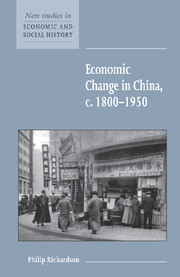Book contents
- Frontmatter
- Contents
- List of maps
- Acknowledgements
- Note on references
- Guide to pronunciation
- Dynastic chronology
- Weights and measures
- Map 1: China: provinces and cities
- Introduction
- 1 Analytical frameworks
- 2 The eighteenth-century legacy and the early nineteenth-century crisis
- 3 Growth and structural change
- 4 Foreign trade and investment
- 5 Industry: traditional and modern
- 6 Agriculture
- 7 The state and the economy
- 8 Conclusion: the legacy of the past
- Bibliography
- Index
- New Studies in Economic and Social History
- Previously published as Studies in Economic and Social History
- Economic History Society
3 - Growth and structural change
Published online by Cambridge University Press: 05 June 2012
- Frontmatter
- Contents
- List of maps
- Acknowledgements
- Note on references
- Guide to pronunciation
- Dynastic chronology
- Weights and measures
- Map 1: China: provinces and cities
- Introduction
- 1 Analytical frameworks
- 2 The eighteenth-century legacy and the early nineteenth-century crisis
- 3 Growth and structural change
- 4 Foreign trade and investment
- 5 Industry: traditional and modern
- 6 Agriculture
- 7 The state and the economy
- 8 Conclusion: the legacy of the past
- Bibliography
- Index
- New Studies in Economic and Social History
- Previously published as Studies in Economic and Social History
- Economic History Society
Summary
The attempt to quantify ex post facto the level, structure and growth of national income prior to 1949 offers the means by which the timing of the onset of modern economic growth (defined as sustained increases in aggregate and per capita output) can be established and the emergence of structural change associated with modernisation identified. The construction of estimates for the individual components of a nation's income (Gross Domestic Product (GDP) is the conventional measure in the literature on China) is a difficult and complex process. It requires an intimate understanding of the nature of the Chinese economy, a familiarity with the available data and an acute awareness of their limitations, and a command over the statistical techniques involved in national income accounting.
Any discussion of the outcome of the various attempts to quantify China's economic experience must, out of caution, begin with a health warning concerning their ability to reflect accurately the contemporary economic reality. There was no systematic compilation of statistics, either governmental or private, for output or income prior to the 1950s. As a result, the cupboard labelled ‘quantitative data’ is bare for the nineteenth century and less than half-stocked for the first half of the twentieth. No more than the first tentative steps towards uncovering the structure and growth of national income have been taken and it is only for modern industry that it has been possible to compile a series which commands confidence [92: 85].
- Type
- Chapter
- Information
- Economic Change in China, c.1800–1950 , pp. 25 - 39Publisher: Cambridge University PressPrint publication year: 1999

